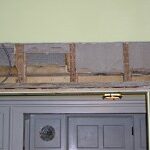Repairing large holes in drywall is a relatively easy do-it-yourself task. It will take a few hours but there is no reason you cannot do this yourself as long as you have basic skills—the ability to measure, use a saw and cut straight lines.
How do you know when a hole is too large to repair with mesh tape and drywall compound?
 As a general rule, holes larger than 12 inches across are too large for metal drywall patches or just using mesh tape. The tape would just sag or tear under the weight of the compound and the patch isn’t rigid enough. So, for really big holes the damaged area must be removed and a new piece of drywall installed. Otherwise, the repair will prove unsatisfactory.
As a general rule, holes larger than 12 inches across are too large for metal drywall patches or just using mesh tape. The tape would just sag or tear under the weight of the compound and the patch isn’t rigid enough. So, for really big holes the damaged area must be removed and a new piece of drywall installed. Otherwise, the repair will prove unsatisfactory.
There are two common ways to repair large drywall holes.
The Stud to Stud Method and the Furring Strip Method. The Stud to Stud Method involves cutting the damaged area all the way to the studs, then screwing a new piece of drywall to the studs. The Furring Strip Method requires attaching wood pieces which are called furring strips. They can be attached to studs inside the hole as support for the new drywall to screw into. They can also be attached directly to the drywall.
Let’s learn how to choose which of these two large drywall hole repair methods is the best choice for your situation.
The stud method is most often used when large sections of drywall needing to be replaced and the stud placement matches the dimensions of a drywall sheet. In a normal installation, drywall is attached to the vertical studs, spanning the space between studs unsupported.
The furring method is best for situations where the span between studs is irregular or where the depth of the studs varies. A patch cannot end unsupported between studs. It would be too easy to push the patch into the wall. A properly-installed furred-in drywall patch is supported on all sides of the insertion.
Furring strips can be used as fillers to fix mismatches between studs and drywall sheets. The strips are also a useful in older homes to compensate for a lot of structural movement. They are a good solution when square drywall sheets don’t quite mesh with walls and ceilings which have not been truly square for many years. Furring strips can also be used to attach drywall away from studs. The most common reason for this is to create additional space within walls for insulation.
For drywall holes which are fairly large but not large enough to replace an entire drywall sheet, furring strips will add strength to patch repairs. If the drywall hole is between two studs, and you don’t want to make the hole larger, which you must do if you use the stud-to-stud method, furring strips could provide adequate strength when used to hold the patch.

